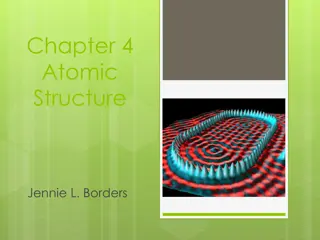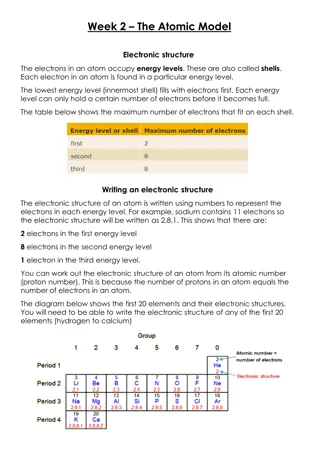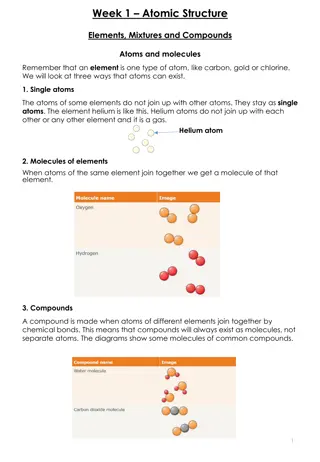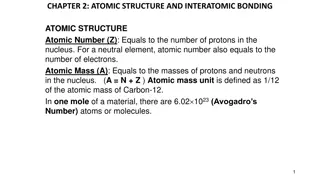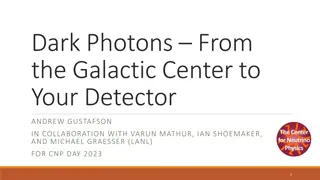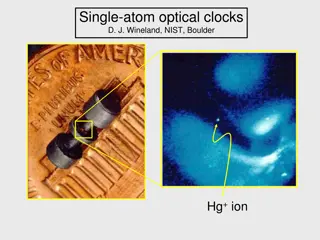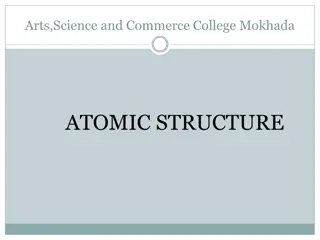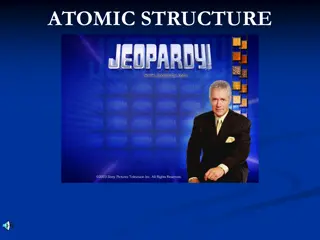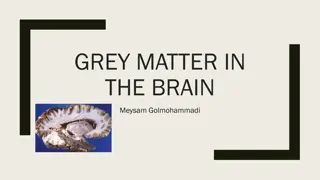Unveiling the Atomic Theory of Matter: Highlights
Matter comprises atoms and molecules in continuous motion, as evidenced by Brownian motion. The precise size of atoms was estimated at 10^-10 meters through experiments. The arrangements of molecules differ in solids, liquids, and gases, with Feynman highlighting the significance of the atomic hypothesis. Atomic and molecular masses are measured in unified atomic mass units, with the carbon-12 atom serving as a reference point. Protons and neutrons contribute to the molecular mass of nitrogen gas.
Download Presentation

Please find below an Image/Link to download the presentation.
The content on the website is provided AS IS for your information and personal use only. It may not be sold, licensed, or shared on other websites without obtaining consent from the author.If you encounter any issues during the download, it is possible that the publisher has removed the file from their server.
You are allowed to download the files provided on this website for personal or commercial use, subject to the condition that they are used lawfully. All files are the property of their respective owners.
The content on the website is provided AS IS for your information and personal use only. It may not be sold, licensed, or shared on other websites without obtaining consent from the author.
E N D
Presentation Transcript
The Atomic Theory of Matter (just the highlights)
Atomic Theory of Matter Matter is composed of atoms & molecules Atoms & molecules are in continuous random motion Brown, 1827: Brownian motion of pollen particles in water Einstein, 1905: Theory Perrin, 1908: Precise experiments Obtained approximate size of atoms: 10-10 m
Atomic Theory of Matter The arrangements of molecules in solids, liquids, and gases are quite different Solid
Atomic Theory of Matter The arrangements of molecules in solids, liquids, and gases are quite different Solid Liquid
Atomic Theory of Matter The arrangements of molecules in solids, liquids, and gases are quite different Solid Liquid Gas
Richard Feynman: If, in some cataclysm, all scientific knowledge were to be destroyed, and only one sentence passed on to the next generation of creatures, what statement would contain the most information in the fewest words? I believe it is the atomic hypothesis that all things are made of atoms little particles that move around in perpetual motion, attracting each other when they are a little distance apart, but repelling upon being squeezed into one another. In that one sentence, you will see, there is an enormous amount of information about the world, if just a little imagination and thinking are applied.
Atomic Theory of Matter Atomic and molecular masses are measured in unified atomic mass units (u) Definition: The carbon-12 atom has a mass of exactly 12.0000 u. Expressed in kilograms: 1 u = 1.6605 10 27 kg
= # of protons Nitrogen: 7 protons & 7 neutrons Nitrogen gas molecule: N2 has molecular mass about 28 u
Atomic Theory of Matter Quantities of matter are often expressed in moles A mole is a specific number of things (e.g., molecules) NA = 6.02 1023 (Avagadro s number) A dozen is 12 things A mole is 6.02 1023 things
Definition: 1 mole of carbon-12 atoms has a mass of 12 grams A mole (mol) of a substance has a mass (in grams) that is numerically equal to the molecular mass (in u) of that substance. = 1 mole of something (molecular mass in u) grams
= 1 mole of something (molecular mass in u) grams 1 mole of Ne has a mass of 20 grams
= 1 mole of something (molecular mass in u) grams 1 mole of N2 has a mass of 28 grams 1 mole of CO2 has a mass of 12 + 2(16) = 44 grams
= 1 mole of something (molecular mass in u) grams Use this for unit conversions: How many moles are in 1 kg of nitrogen gas? 1 mole (of N2) = 28 grams 1000 g 1kg 1mole 28grams = 1kg 35.7 moles
So, how big are atoms? How can that even be answered?
Example 13-1: Distance between atoms The density of copper is 8.9x103 kg/m3, and each copper atom has a mass of 63 u. Estimate the average distance between the centers of neighboring copper atoms. Consider 1 cubic meter of copper. That s 8.9x103 kg. How many atoms are there? Assume that the atoms are in a square lattice like this: Recall: 1 u = 1.6605 10 27 kg So one atom of Cu has mass 27 1.6605 10 kg = 25 63u 1.05 10 kg. 1u 3 8.9 10 kg 1.05 10 = 8.5 10 atoms 28 The number of atoms is 25 kg/atom
Example 13-1: Distance between atoms The density of copper is 8.9x103 kg/m3, and each copper atom has a mass of 63 u. Estimate the average distance between the centers of neighboring copper atoms. 8.5 10 28 With atoms arranged in a square lattice, Assume that the atoms are in a square lattice like this: there are atoms aligned on each side. 8.5 10 3 28 8.5 10 = 4.4 10 atoms 3 28 9 Since each side is 1 m in length, the distance between atoms is 1m = 2.3 10 10 m 4.4 10 atoms 9 10 ~10 m So it s reasonable to think of as the size of an atom
10 ~10 m So it s reasonable to think of as the size of an atom 1 Angstrom = 1 Anders Jonas ngstr m Whatever the atom is, it fits into a sphere of approximately that diameter
iClicker Question Do you know what a quark is? A Yes B No 20
iClicker Question All of the following particles are found in the nucleus of an atom except A protons B neutrons C quarks D electrons E all of the above particles are found in nuclei of atoms 25
iClicker Question Which of the following is NOT a type of quark? A Up B Down C Top D Bottom E Side 26
Modern Atomic Physics V Neutrinos are produced in the Weak Interaction , for example Neutrinos from the earth natural radioactivity Man-made neutrinos accelerators, nuclear power plants. Astrophysical neutrinos Solar neutrinos Atmospheric neutrinos Relic neutrinos left over from the big bang. 27
Neutrino Detection Detecting neutrinos requires a different kind of a detector. 28
Neutrino Factoids The earth receives about 40 billion neutrinos per second per cm2 from the sun. About 100 times that amount are passing through us from the big bang. This works out to about 330 neutrinos in every cm3 of the universe! By comparison there are about 0.0000005 protons per cm3 in the universe. Your own body emits about 340 million neutrinos per day from 40K. Neutrinos don t do much when passing through matter. Thus, it is very difficult to observe neutrinos. 29
Neutrino Detection II Neutrinos are observed by detecting the product of their interaction with matter. e Electron Muon 30
iClicker Question Which of the following sub-atomic particles interacts least with matter? A protons B neutrons C quarks D electrons E neutrinos 31
Neutrinos reveal information about the Suns core and have surprises of their own Neutrinos emitted in thermonuclear reactions in the Sun s core were detected, but in smaller numbers (1/3) than expected Recent neutrino experiments explain why this is so Based upon conversion of electron neutrino to tau neutrino 32






